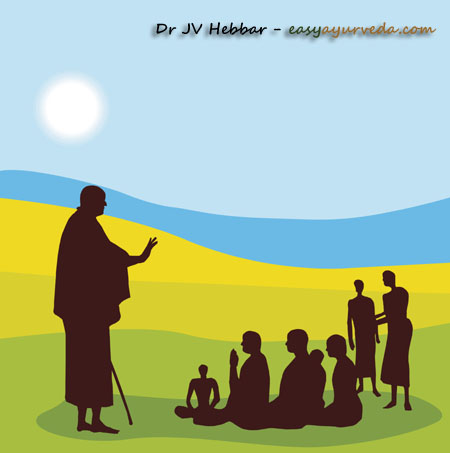Madhava Nidana Chapter 16 Trishna Nidanam
This article explains Madava nidana 16th chapter “Trishna Nidanam”. Causes, pathology and symptoms of Trishna are explained in this chapter.
Read – Acharya Madhavakara: His Work ‘Madhava Nidana’, Legacy, Amazing Facts

Table of Contents
Trishna Samprapti
Pathogenesis of Trishna
Pitta which has undergone increase due to its etiological factors (pitta aggravating factors like excessive consumption of pungent, hot, corrosive foods, anger, consumption of alcohol etc) gets association of vata which has undergone increase due to fear, physical exhaustion (fatigue) and loss of strength. Now, this pitta along with vata reaches the palate, gets lodged therein and produces severe thirst. This condition is called Trishna .
Also, Trishna – thirst may be manifested when the vitiated doshas contaminate the channels transporting water (organs controlling the water balance and supply in the body). (1)
Pathway of pathogenesis of Trishna
- Pitta aggravated by its own etiological factors
- Finds association of vata which has undergone aggravation due to fear, physical exertion and loss of physical strength
- Both doshas reach and get lodged in the palate (or contaminate the water transporting channels) and
- Cause severe thirst – this condition is called as Trishna
Read – Excessive Thirst – Ayurvedic Understanding And Treatment
Trisna Purvarupa, Rupa
Premonitory symptoms and symptoms of Trishna
Purvarupa – The premonitory symptoms of Trisna are – dryness and also burning sensation of the palate, lips, throat and mouth, increased temperature in the entire body, dizziness, and delirium.
Rupa / Lakshanas – When the same symptoms mentioned in the premonitory symptoms clearly manifest in a stronger way they become the lakshanas or symptoms of Trisna disease.
Types of Trishna
Trishna is of seven kinds, one from each dosa, the fourth from injury (ulcerations), the fifth one due to the depletion (loss) of body tissues, the sixth one from ama (excessive accumulation of undigested materials formed due to sluggish digestion in the stomach) and the seventh one is caused by food (consumption of bad foods). The symptoms of all these types of Trishna will be described further. (2)
The 7 types of Trsna are –
- Vataja Trishna
- Pittaja Trishna
- Kaphaja Trishna
- Kshataja Trishna
- Kshayaja Trishna
- Amaja Trishna
- Bhaktodbhava Trishna
Read- Vega Dharana: Suppression of urges, types, symptoms, and management
Symptoms
Vataja Trisna
The symptoms of Vataja Trsna are – pinched or dry face, pricking pain in the temples and head, obstruction of the channels of transportation of nutrition and water, manifestation of bad tastes in the mouth and increase of thirst on drinking cold water. (3)
Pittaja Trisna
The symptoms of pittaja trsna are – fainting (loss of consciousness), aversion to food, delirium, burning sensation, reddish eyes, constant dryness (due to immense thirst all the tissues of the body dry up continuously), liking towards cold things / cold comforts, manifestation of bitter taste in the mouth, feel of discomfort in the entire body or smoke (hot fumes) being eliminated from the entire body, and yellowish discoloration of faeces, urine, eyes skin etc. (4)
Kaphaja Trushna
Pathogenesis of kaphaja trsna – The kapha which has been aggravated due to its own causes (etiological factors causing aggravation of kapha) envelopes (destroys, puts off) the digestive fire. This leads to obstruction of heat in the channels of transportation of water. This will further lead to manifestation of trsna. Such a thirst caused by kapha is called kaphaja trsna.
The symptoms of kaphaja trsna are – excessive sleep, heaviness of the body, manifestation of sweet taste in the mouth and excessive emaciation (quick emaciation) of the body of the patient. (5)
Read – Lifestyle, Food And Factors That Cause Increase Of Kapha Dosha
Ksataja Trushna
Ksataja Trsna – This type of thirst manifests as a result of excessive bleeding and pain caused due to injury.
Ksayaja Trushna
Ksayaja Trishna – This type of thirst manifests due to loss of rasa tissue (the first and predominantly watery tissue of the body). The person suffering from this type of thirst repeatedly drinks water during day time and also at night but the thirst is not relieved by any amount of water intake. Along with this, the symptoms of rasa ksaya (symptoms of decrease of rasa tissue including pain, tremors, feeling of dryness and emptiness in the region of heart, dryness of the mouth, skin etc) are also manifested.
Some authorities consider this type of Trishna (ksayaja Trishna ) as sannipātaja (caused by all three doses together). (6-7)
Read – Charaka Trishna Chikitsa – Dry Mouth- 22nd Chapter
Amaja Trishna
In this type of thirst, the combined symptoms of all the three doshas are seen.
Apart from this, pain in the region of the heart, excessive spitting of sputum and weakness (always lying down) are found as specific symptoms.
Bhaktodbhava Trishna
Bhaktodbhava / Annaja Trishna – This kind of thirst is produced by excessive consumption of unctuous (fatty), sour, salty and heavy foods. (8)
Upasargaja Trishna
Signs of thirst manifested as a complication of other diseases
It is very difficult to treat patients of thirst in whom there is manifestation of –
- Suppression of voice / feeble voice
- Repeated fainting (goes into state of unconsciousness repeatedly)
- Tiredness / restless (feel of helplessness)
- Dryness of mouth, throat and palate
- Excessive emaciation
This type of thirst caused as a complication of other diseases is called as upasargaja Trishna. (9)
Read – Trishna Nigrahana Gana – Thirst Quenching Herb Group Of Charaka

Complications of Trishna
Fever, delusion, emaciation, cough, dyspnoea (increased / difficult respiration) are the complications of Trishna . (According to others these are the causes of upasargaja Trishna mentioned above i.e., people suffering from these diseases can develop upasargaja trsna).
Any type of Trishna , which is very severe and persists for long (continuously present) is incurable. Thirst manifesting in persons who have been debilitated or emaciated by other diseases, in those who have continuous bouts of vomiting and those associated with complications will definitely cause death. (10-11)
Thus ends the chapter on Trishna Nidanam in Madhava Nidana text written by Acharya Madhavakara.










